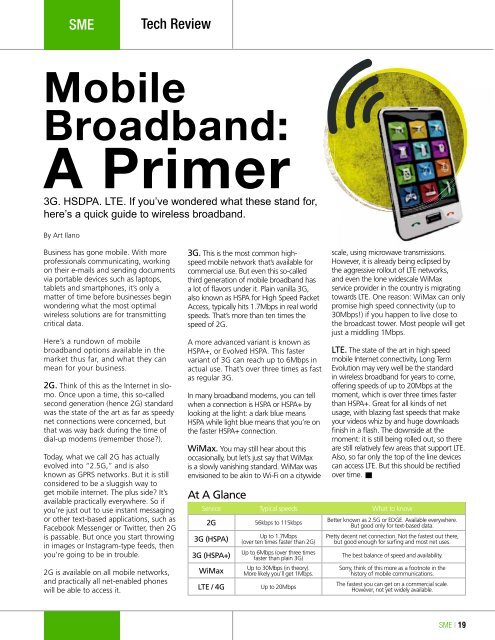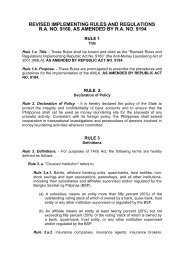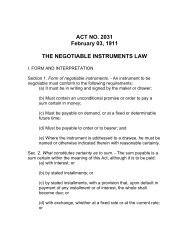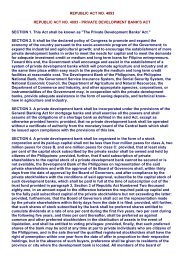The Innovators - Planters Development Bank
The Innovators - Planters Development Bank
The Innovators - Planters Development Bank
Create successful ePaper yourself
Turn your PDF publications into a flip-book with our unique Google optimized e-Paper software.
SME<br />
Tech Review<br />
Mobile<br />
Broadband:<br />
A Primer<br />
3G. HSDPA. LTE. If you’ve wondered what these stand for,<br />
here’s a quick guide to wireless broadband.<br />
By Art Ilano<br />
Business has gone mobile. With more<br />
professionals communicating, working<br />
on their e-mails and sending documents<br />
via portable devices such as laptops,<br />
tablets and smartphones, it’s only a<br />
matter of time before businesses begin<br />
wondering what the most optimal<br />
wireless solutions are for transmitting<br />
critical data.<br />
Here’s a rundown of mobile<br />
broadband options available in the<br />
market thus far, and what they can<br />
mean for your business.<br />
2G. Think of this as the Internet in slomo.<br />
Once upon a time, this so-called<br />
second generation (hence 2G) standard<br />
was the state of the art as far as speedy<br />
net connections were concerned, but<br />
that was way back during the time of<br />
dial-up modems (remember those?).<br />
Today, what we call 2G has actually<br />
evolved into “2.5G,” and is also<br />
known as GPRS networks. But it is still<br />
considered to be a sluggish way to<br />
get mobile internet. <strong>The</strong> plus side? It’s<br />
available practically everywhere. So if<br />
you’re just out to use instant messaging<br />
or other text-based applications, such as<br />
Facebook Messenger or Twitter, then 2G<br />
is passable. But once you start throwing<br />
in images or Instagram-type feeds, then<br />
you’re going to be in trouble.<br />
2G is available on all mobile networks,<br />
and practically all net-enabled phones<br />
will be able to access it.<br />
3G. This is the most common highspeed<br />
mobile network that’s available for<br />
commercial use. But even this so-called<br />
third generation of mobile broadband has<br />
a lot of flavors under it. Plain vanilla 3G,<br />
also known as HSPA for High Speed Packet<br />
Access, typically hits 1.7Mbps in real world<br />
speeds. That’s more than ten times the<br />
speed of 2G.<br />
A more advanced variant is known as<br />
HSPA+, or Evolved HSPA. This faster<br />
variant of 3G can reach up to 6Mbps in<br />
actual use. That’s over three times as fast<br />
as regular 3G.<br />
In many broadband modems, you can tell<br />
when a connection is HSPA or HSPA+ by<br />
looking at the light: a dark blue means<br />
HSPA while light blue means that you’re on<br />
the faster HSPA+ connection.<br />
WiMax. You may still hear about this<br />
occasionally, but let’s just say that WiMax<br />
is a slowly vanishing standard. WiMax was<br />
envisioned to be akin to Wi-Fi on a citywide<br />
At A Glance<br />
scale, using microwave transmissions.<br />
However, it is already being eclipsed by<br />
the aggressive rollout of LTE networks,<br />
and even the lone widescale WiMax<br />
service provider in the country is migrating<br />
towards LTE. One reason: WiMax can only<br />
promise high speed connectivity (up to<br />
30Mbps!) if you happen to live close to<br />
the broadcast tower. Most people will get<br />
just a middling 1Mbps.<br />
LTE. <strong>The</strong> state of the art in high speed<br />
mobile Internet connectivity, Long Term<br />
Evolution may very well be the standard<br />
in wireless broadband for years to come,<br />
offering speeds of up to 20Mbps at the<br />
moment, which is over three times faster<br />
than HSPA+. Great for all kinds of net<br />
usage, with blazing fast speeds that make<br />
your videos whiz by and huge downloads<br />
finish in a flash. <strong>The</strong> downside at the<br />
moment: it is still being rolled out, so there<br />
are still relatively few areas that support LTE.<br />
Also, so far only the top of the line devices<br />
can access LTE. But this should be rectified<br />
over time.<br />
Service Typical speeds What to know<br />
2G<br />
3G (HSPA)<br />
3G (HSPA+)<br />
WiMax<br />
LTE / 4G<br />
56kbps to 115kbps<br />
Up to 1.7Mbps<br />
(over ten times faster than 2G)<br />
Up to 6Mbps (over three times<br />
faster than plain 3G)<br />
Up to 30Mbps (in theory).<br />
More likely you’ll get 1Mbps.<br />
Up to 20Mbps<br />
Better known as 2.5G or EDGE. Available everywhere.<br />
But good only for text-based data.<br />
Pretty decent net connection. Not the fastest out there,<br />
but good enough for surfing and most net uses.<br />
<strong>The</strong> best balance of speed and availability.<br />
Sorry, think of this more as a footnote in the<br />
history of mobile communications.<br />
<strong>The</strong> fastest you can get on a commercial scale.<br />
However, not yet widely available.<br />
SME | 19

















